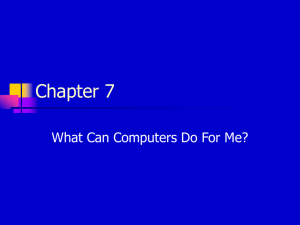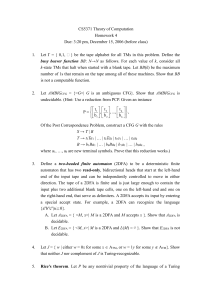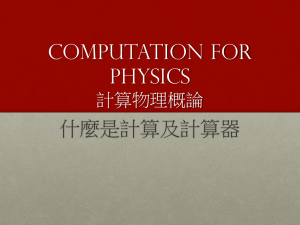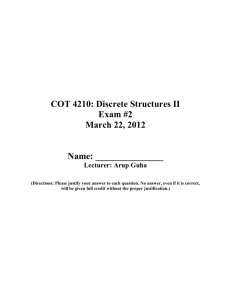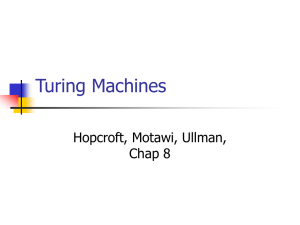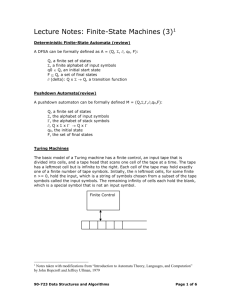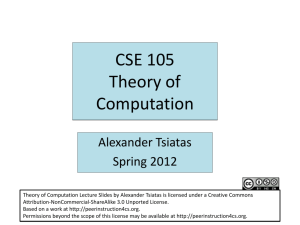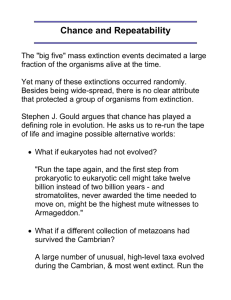Lecture Notes: Finite-State Machines (1)
advertisement
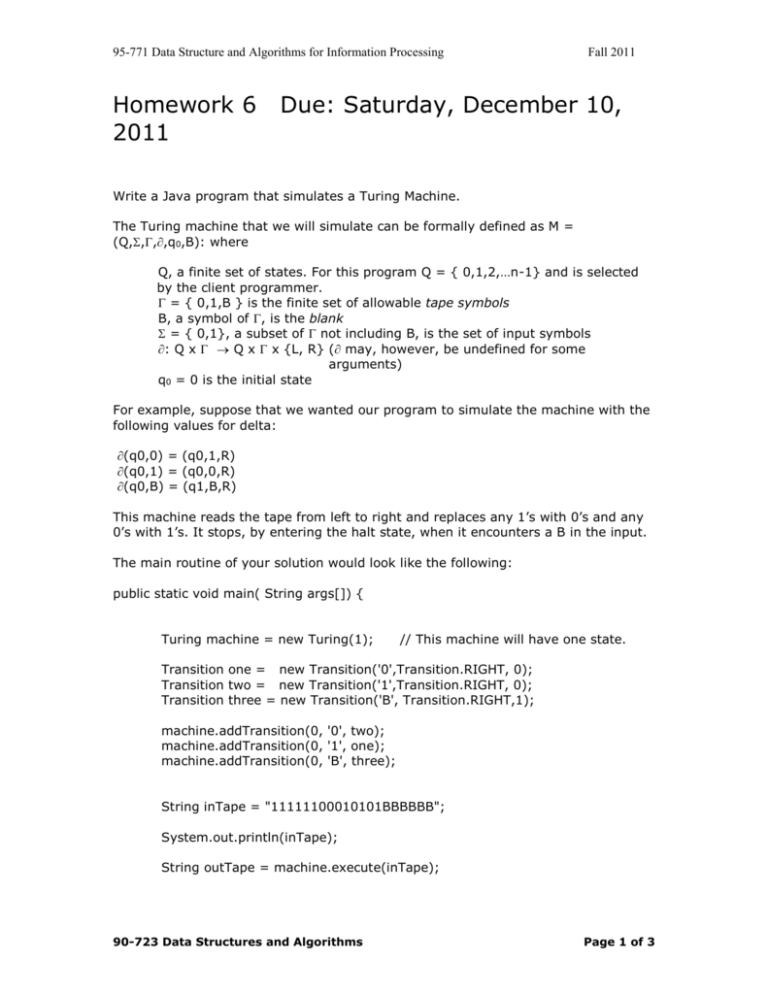
95-771 Data Structure and Algorithms for Information Processing
Homework 6
2011
Fall 2011
Due: Saturday, December 10,
Write a Java program that simulates a Turing Machine.
The Turing machine that we will simulate can be formally defined as M =
(Q,,,,q0,B): where
Q, a finite set of states. For this program Q = { 0,1,2,…n-1} and is selected
by the client programmer.
= { 0,1,B } is the finite set of allowable tape symbols
B, a symbol of , is the blank
= { 0,1}, a subset of not including B, is the set of input symbols
: Q x Q x x {L, R} ( may, however, be undefined for some
arguments)
q0 = 0 is the initial state
For example, suppose that we wanted our program to simulate the machine with the
following values for delta:
(q0,0) = (q0,1,R)
(q0,1) = (q0,0,R)
(q0,B) = (q1,B,R)
This machine reads the tape from left to right and replaces any 1’s with 0’s and any
0’s with 1’s. It stops, by entering the halt state, when it encounters a B in the input.
The main routine of your solution would look like the following:
public static void main( String args[]) {
Turing machine = new Turing(1);
// This machine will have one state.
Transition one = new Transition('0',Transition.RIGHT, 0);
Transition two = new Transition('1',Transition.RIGHT, 0);
Transition three = new Transition('B', Transition.RIGHT,1);
machine.addTransition(0, '0', two);
machine.addTransition(0, '1', one);
machine.addTransition(0, 'B', three);
String inTape = "11111100010101BBBBBB";
System.out.println(inTape);
String outTape = machine.execute(inTape);
90-723 Data Structures and Algorithms
Page 1 of 3
95-771 Data Structure and Algorithms for Information Processing
Fall 2011
System.out.println(outTape);
}
And the output of this program is shown below:
C:\McCarthy\www\95-771\TuringMachine>java Turing
11111100010101BBBBBB
00000011101010BBBBBB
Below is an example Turing machine program.
Proper subtraction m – n is defined to be m – n for m >= n, and zero for m < n. The
TM
M = ( {q0,q1,...,q6}, {0,1}, {0,1,B}, , q0, B, {} )
defined below, if started with 0m10n on its tape, halts with 0m-n on its tape. M
repeatedly replaces its leading 0 by blank, then searches right for a 1 followed by a 0
and changes the 0 to a 1. Next, M moves left until it encounters a blank and then
repeats the cycle. The repetition ends if
i)
ii)
Searching right for a 0, M encounters a blank. Then, the n 0’s in 0 m10n
have all been changed to 1’s, and n+1 of the m 0’s have been changed
to B. M replaces the n+1 1’s by a 0 and n B’s, leaving m-n 0’s on its
tape.
Beginning the cycle, M cannot find a 0 to change to a blank, because
the first m 0’s already have been changed. Then n >= m, so m – n =
0. M replaces all remaing 1’s and 0’s by B.
The function is described below.
(q0,0) = (q1,B,R)
Begin. Replace the leading 0 by B.
(q1,0) = (q1,0,R)
(q1,1) = (q2,1,R)
Search right looking for the first 1.
(q2,1) = (q2,1,R)
(q2,0) = (q3,1,L)
Search right past 1’s until encountering a 0. Change that 0 to 1.
(q3,0) = (q3,0,L) Move left to a blank. Enter state q0 to repeat the cycle.
(q3,1) = (q3,1,L)
(q3,B) = (q0,B,R)
If in state q2 a B is encountered before a 0, we have situation i
described above. Enter state q4 and move left, changing all 1’s
to B’s until encountering a B. This B is changed back to a 0,
state q6 is entered and M halts.
(q2,B) = (q4,B,L)
(q4,1) = (q4,B,L)
(q4,0) = (q4,0,L)
(q4,B) = (q6,0,R)
If in state q0 a 1 is encountered instead of a 0, the first block
of 0’s has been exhausted, as in situation (ii) above. M enters
90-723 Data Structures and Algorithms
Page 2 of 3
95-771 Data Structure and Algorithms for Information Processing
Fall 2011
state q5 to erase the rest of the tape, then enters q6 and halts.
(q0,1)
(q5,0)
(q5,1)
(q5,B)
= (q5,B,R)
= (q5,B,R)
= (q5,B,R)
= (q6,B,R)
In this homework, you will write a Turing machine and execute it on your simulator.
Your machine will descide the language of unary multiplication of positive integers.
We will define the language
UnaryMult = { 1nB1MB1nXm | m,n are integers greater than 0 }
Your simulator will read strings and accept all and only those strings that are
members of UnaryMult.
Your Java program will be interactive and its execution will appear as follows :
Java UnaryMultTester
Enter input tape : 11111 11 1111111111
Output tape : 1
Java UnaryMultTester
Enter input tape : 11 11 111
Output tape : 0
After examining the string, your Turing machine will leave only a 0 or a 1 on the
input tape. This will be the value returned by the execute method of your Turing
machine.
Submit to Blackboard the documented Java code that you used to simulate the
machine. Your main routine should look almost identical to the main routine above.
The only major differences should be the way the input tape is established (we are
reading these data from the user), the size of the machine (it will have mores states)
and the assignments to delta via addTransition(). These assignments will represent
the Turing machine that is being simulated.
It is important that the class Turing not know anything about multiplication. It should
be programmed with the delta transitions to perform all of its application specific
activities.
90-723 Data Structures and Algorithms
Page 3 of 3
